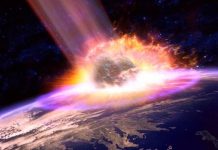
The European Space Agency’s (Esa) Goce satellite has re-entered the Earth’s atmosphere, burning up in the process.
US tracking data suggests any surviving debris fell into the South Atlantic, just off the tip of South America, south of the Falkland Islands.
Dubbed the “Ferrari of space” because of its sleek looks, Goce is the first Esa mission to make an uncontrolled re-entry in more than 25 years.
The gravity mapping probe’s plunge was inevitable once it ran out of fuel.
The mission was operating in an extremely low orbit – at 224km altitude, the lowest of any scientific satellite – and needed to constantly thrust an electric engine to stay aloft, but last month its reserves of xenon fuel were exhausted.
Pre-return modelling had indicated that perhaps a fifth to a quarter of Goce’s one-tonne mass could have endured the fiery fall through the atmosphere.
Its sophisticated gradiometer – the instrument used to make gravity measurements – incorporated composite materials which were expected to ride out the destructive forces that would ordinarily incinerate traditional components.
Tracking project
The Inter-Agency Space Debris Coordination Committee – the global forum on “space junk” – chose Goce as its special study project for 2013. This meant a large number of tracking and surveillance facilities around the world were activated to monitor the satellite’s descent to Earth.
A signal from Goce was last acquired at 22:42 GMT on Sunday as it passed 121km (75 miles) above Antarctica. Data from the United States Strategic Command (USSTRATCOM) indicated that re-entry occurred a little over one orbit of the Earth later, with the spacecraft starting to break up at 00:16 GMT on Monday at an altitude of about 80km.
This would have put any debris fall in the South Atlantic just east of Tierra Del Fuego.
“Goce survived for a few minutes longer than we expected – but since re-entries are difficult to predict, this is not very surprising,” Holger Krag from Esa’s Space Debris Office told BBC News.
Source: BBC Science

![20131112-190357[1]](https://coolinterestingnews.com/wp-content/uploads/2013/11/20131112-1903571.jpg)












